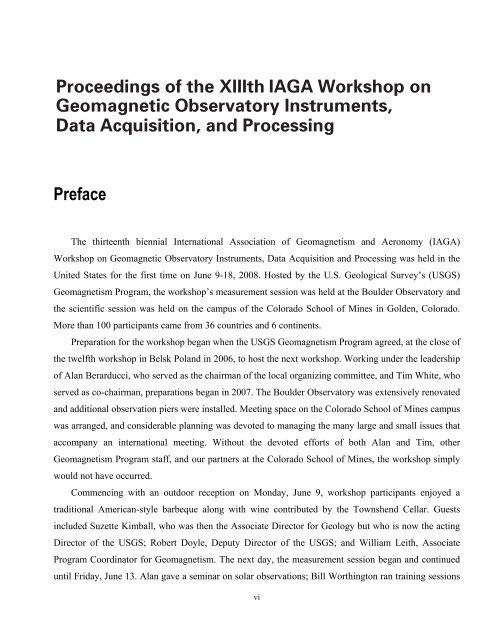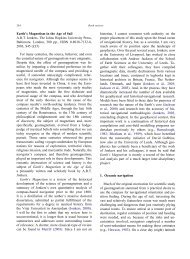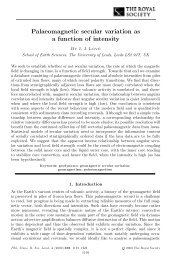Preface - USGS Geomagnetism Program
Preface - USGS Geomagnetism Program
Preface - USGS Geomagnetism Program
You also want an ePaper? Increase the reach of your titles
YUMPU automatically turns print PDFs into web optimized ePapers that Google loves.
Proceedings of the XIIIth IAGA Workshop on<br />
Geomagnetic Observatory Instruments,<br />
Data Acquisition, and Processing<br />
<strong>Preface</strong><br />
The thirteenth biennial International Association of <strong>Geomagnetism</strong> and Aeronomy (IAGA)<br />
Workshop on Geomagnetic Observatory Instruments, Data Acquisition and Processing was held in the<br />
United States for the first time on June 9-18, 2008. Hosted by the U.S. Geological Survey’s (<strong>USGS</strong>)<br />
<strong>Geomagnetism</strong> <strong>Program</strong>, the workshop’s measurement session was held at the Boulder Observatory and<br />
the scientific session was held on the campus of the Colorado School of Mines in Golden, Colorado.<br />
More than 100 participants came from 36 countries and 6 continents.<br />
Preparation for the workshop began when the <strong>USGS</strong> <strong>Geomagnetism</strong> <strong>Program</strong> agreed, at the close of<br />
the twelfth workshop in Belsk Poland in 2006, to host the next workshop. Working under the leadership<br />
of Alan Berarducci, who served as the chairman of the local organizing committee, and Tim White, who<br />
served as co-chairman, preparations began in 2007. The Boulder Observatory was extensively renovated<br />
and additional observation piers were installed. Meeting space on the Colorado School of Mines campus<br />
was arranged, and considerable planning was devoted to managing the many large and small issues that<br />
accompany an international meeting. Without the devoted efforts of both Alan and Tim, other<br />
<strong>Geomagnetism</strong> <strong>Program</strong> staff, and our partners at the Colorado School of Mines, the workshop simply<br />
would not have occurred.<br />
Commencing with an outdoor reception on Monday, June 9, workshop participants enjoyed a<br />
traditional American-style barbeque along with wine contributed by the Townshend Cellar. Guests<br />
included Suzette Kimball, who was then the Associate Director for Geology but who is now the acting<br />
Director of the <strong>USGS</strong>; Robert Doyle, Deputy Director of the <strong>USGS</strong>; and William Leith, Associate<br />
<strong>Program</strong> Coordinator for <strong>Geomagnetism</strong>. The next day, the measurement session began and continued<br />
until Friday, June 13. Alan gave a seminar on solar observations; Bill Worthington ran training sessions<br />
vi
for making absolute measurements; Paul Hattori and Andy Woods processed all the measurement data;<br />
Tim ran the total field comparison sessions; Duff Stewart and Eddie McWhirter demonstrated the <strong>USGS</strong><br />
data acquisition system; Jill Caldwell and Duff ran training sessions for data processing; Tim and Ed<br />
Sauter gave a tour of the <strong>USGS</strong> coil calibration system; Jean Rasson demonstrated an automated<br />
absolute measurement system (p. 220); Jeffrey Love, Jean, and Tim conducted a discussion session on<br />
1-second data acquisition issues; and William Denig, Sue McLean, and Chris Balch hosted workshop<br />
participants for a tour of the National Geophysical Data Center and the Space Weather Prediction<br />
Center at NOAA. The results of side-by-side comparisons of absolute field measurements, made using<br />
DI Flux (theodolite) and Overhauser and proton-precession magnetometers, are given on p. 1 and 9 of<br />
these proceedings. The workshop’s measurement session was a busy time, and those involved worked<br />
hard in making it a success. This part of the workshop is important for ensuring that observatories<br />
around the world are operated according to a consistent set of modern standards.<br />
After a weekend that included a mountain tour led by <strong>USGS</strong> geologists, another barbeque, and free<br />
time, the three-day scientific session began on Monday June 16. Welcoming words were given by David<br />
Applegate, the <strong>USGS</strong> Senior Science Advisor for Earthquakes and Geologic Hazards. The session’s<br />
first invited speaker, Robert McPherron, professor of space physics at UCLA, spoke on magnetospheric<br />
physics and observatory data (p. 171). This was followed by contributed oral presentations on<br />
magnetometer networks, individual observatories, and testing of 1-second data. That evening, a banquet<br />
dinner was held at a downtown Denver restaurant. On Tuesday, Leif Svalgaard gave an invited talk on<br />
the analysis of historical observatory data and the Sun-Earth connection (p. 246). Professor John<br />
Cowdrey, Colorado School of Mines, gave a presentation on the history of electricity distribution in the<br />
United States, and Tom Lawson gave a presentation on analog to digital technology. Contributed oral<br />
presentations were given on data management and long-time series, and there was some animated<br />
discussion about the errors in hourly mean data when one or more minutes of data are missing. We then<br />
had an extended period of time for poster presentations, which was accompanied by drinks and hors<br />
d’oeuvres. On Wednesday, Manoj Nair gave an invited talk on oceanic magnetic induction; we had<br />
contributed oral presentations on the internal field, absolute measurement methods, repeat surveys and<br />
regional analyses; and Jeff, Chris, and Arnaud Chulliat led a discussion session on the importance of<br />
real-time dissemination of preliminary magnetic observatory data and the prompt publication of<br />
definitive data. Madeeha Ashfaque (p. 146) gave a presentation on geomagnetic observatories in<br />
vii
Pakistan, and she was later awarded the IAGA Young Scientist Presentation Award, to which we add<br />
our congratulations!<br />
The proceedings that follow are a partial record of the workshop. The first two papers record the<br />
results of the measurement session, and the rest of the papers apply to the scientific session. Many<br />
presentations, both oral and poster, formed an important part of the workshop, and the Conference<br />
<strong>Program</strong> and Abstracts, distributed at the time of the workshop, is record of these. But for reference, a<br />
list of the abstracts delivered at the workshop is given at the end of these proceedings. As has been the<br />
case with previous observatory workshops, much fruitful conversation and exchange occurred during<br />
the measurement session, the field trips, and, even, over the breakfasts, lunches, dinners, and coffee<br />
breaks that participants shared together. Indeed, the congeniality of the community of people within the<br />
international community of observatories is impressive. And so, we express special appreciation to<br />
everyone who participated in the workshop. In particular, we hope that our foreign guests felt welcome<br />
in the United States.<br />
We express our thanks to Jill McCarthy, the <strong>USGS</strong> Central Region Geologic Hazards Team Chief<br />
Scientist; Carol A. Finn, the Group Leader of the <strong>USGS</strong> <strong>Geomagnetism</strong> <strong>Program</strong>; the <strong>USGS</strong><br />
International Office; and Melody Francisco of the Office of Special <strong>Program</strong>s and Continuing Education<br />
of the Colorado School of Mines. We also thank the student employees that the <strong>Geomagnetism</strong> <strong>Program</strong><br />
has had over the years and leading up to the time of the workshop. For preparation of the proceedings,<br />
thanks go to Eddie and Tim. And, finally, we thank our sponsors, the <strong>USGS</strong>, IAGA, and the Colorado<br />
School of Mines.<br />
Jeffrey J. Love, Editor<br />
viii






